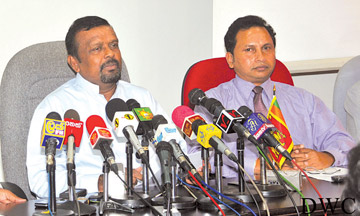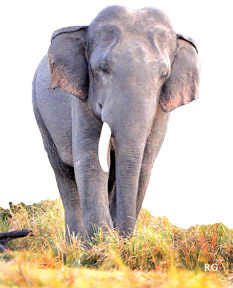Growing elephant herds, a healthy trend - Santiapillai
By Dhaneshi YATAWARA
|

The Minneriya herd
|
Today we know that this island nation is the home to more than 5,800
Sri Lankan Elephants (‘Elephas maximus maximus’). According to wildlife
experts it is significantly high, considering the total population of
Asian elephants. ‘Elephas maximus maximus’ is the largest of the Asian
kind. These elephants have the longest gestation period of any land
animal, which is 22 months.
The article ‘Strategy for the conservation of elephants in Sri Lanka’
written by Charles Santiapillai, Prithiviraj Fernanado and Manori
Gunewardene, quoting historical records state that "The elephant has
been protected in Sri Lanka since the l2th century AD. Wild elephants in
the Sinhalese Kingdom were the king’s property and so they could not be
captured or killed without his permission.” This proves that these
gentle giants have been our flagship species for over centuries. Today
more than 5800 elephants are living in the jungles which is about 14
percent of the 65,610 square kilometres – the total land area of the
country. We are yet to find out whether this forest cover is enough for
these magnificent animals to roam.
According to Professor Charles Santiapillai – a senior elephant
expert in the country speaking to the ‘Sunday Observer’ said that the
present survey is an improvement on earlier surveys carried out in 1993,
2004 and 2008. “The present survey is the first national survey of wild
elephants in Sri Lanka and covered as much as possible the geographic
range of the elephant in the wild. This is also the first time, the
department of Wildlife Conservation has enlisted the services of an
experienced Statistician from the University of Peradeniya to analyse
the data so that errors due to double counting of elephants could be
reduced.
 |
| Minister S.M. Chandrasena
and Wildlife DG, H.D. Ratnayake at the press conference held
last Friday |
In addition to the observers placed at these observation points, the
DWC also used a number of mobile patrols to cover large areas,” Prof.
Santiapillai added explaining his first hand experience in the Survey
that was conducted from 11 – 14 August this year in all wildlife
regions. In the Northern region, where a survey has never taken place
for nearly two and a half decades, observers found 233 elephants.
Santiapillai said this survey was planned to get information on the
population structure and composition but not solely meant to be a census
of elephants, as the latter is almost impossible in Sri Lanka and
elsewhere in Asia given the dense and tangled nature of the vegetation.
Elephants, given protection and access to food, water and cover,
would increase. “No other country in Asia offers such a rich and diverse
habitat for elephants like Sri Lanka. Thus the long-term survival
prospects for the elephant in Sri Lanka are good provided we control or
minimise the human-elephant conflict,” he added.
According to the Director General of Wildlife Conservation, H.D.
Ratnayake in earlier statistics 5,350 elephants were counted in Sri
Lanka. The count excluded the Northern and Eastern parts of the country
as terrorist threats existed a few years back. “Sri Lanka is divided
into seven wildlife regions and with the support of more than 3500
observers the entire area,” Ratnayake added. “The number of calves,
which is 1107, is a significant factor considering the survival of the
elephant as a species,” he explained. “If the count showed a large adult
population it would be a sign of a problem in the survival of this
animal but fortunately the elephant population is growing and this is a
healthy trend,” Ratnayake said.
Elephants live in a structured social order. The social lives of male
and female elephants are very different. The females spend their entire
life in tightly-knit family groups made up of mothers, daughters,
sisters, and aunts. These groups are led by the eldest female, or
matriarch. Adult males, on the other hand, mostly live solitary lives.
“More calves in the elephant population means that more female
elephants were ready for pregnancy, which shows that there is a
conducive natural habitat for these animals to live in,” explained DWC’s
Deputy Director of Education and Research S.R.B. Dissanayake. “It is
found many researches done in the past that female elephants tend to
delay pregnancy if the environment is not good for their survival such
as scarcity of food and water.
The environment has to be healthy for the healthy growth of the
elephant population,” Dissanayake explained. Elephants prefer secondary
forests to live in. As Dissanayake explained this is because in primary
forests food is not within the reach of the elephant. In such forests
the lush vegetation that provides high nutrition for these herbivores
tend to move up towards the forest canopy. Grasslands and plants at low
levels do not exist in primary forests, thus, elephants cannot live in
every inch of jungle cover.
Many of the forests in the dry zone are secondary forests – other
than for a few notable exceptions such as Wilpattu, Wasgomuwa and Yala
where high forests are. Most areas of the dry zone of Sri Lanka have
come under cultivation at some time in the past. The low country Dry
Zone is dotted with thousands of man-made irrigation reservoirs or
tanks. These tanks and their associated grasslands provide excellent
habitats for elephants and raises the carrying capacity.
|

‘Thani Dalaya’ who is found in Minneriya |
The Accelerated Mahaweli Development Program too has created
conditions that promote elephant population growth with year round
availability of water and access to cultivated crops. These two factors,
i.e., ready availability of fresh water and secondary forests, both due
to human alteration of the landscape are perhaps the main reasons that
Sri Lanka has a very high density of elephants.
Besides its dominant role in the ecosystem, the elephant also
highlights many of the ecological, Economical and philosophical issues
underlying wildlife management
|

Elephants in Wasgamuwa |
Living in this small island with a high density of human population
and rapidly changing vegetation patterns, elephants-may find it
increasingly difficult to live. Elephant herds confine to forest pockets
bringing a great threat for survival which eventually lead to the
human-elephant conflict. Under the ‘Gaja Mithuro’ program, 15 Elephant
Control Units are set up islandwide with the latest in Vavuniya and
Baticaloa. “There were only two units at the beginning in 2009, in
Hambanthota and Galgamuwa.
Yet the DWC continues to expand Elephant Control Units as a part of
the solution to the Human-Elephant conflict,” said W.S.K. Pathiratne,
Deputy Director (Elephant Conservation) of the DWC. Up to now nearly
1400 kilometres of electric fences were have been completed at required
places in the country and another 265 kilometers are under construction
hoping to be completed by the end of this year.
The DWC plans to develop approximately 1000 hectares in Horow-
pothana and 2000 hectares in Lunugamwehera as Elephant holding grounds.
Approximately 1570 hectares of forest circling the Horowpothana Elephant
Holding ground will be upgraded as the Wildlife park.
The Lunugamwehera Holding ground exists in the middle of the
Lunugamwehera National park. The electric fences surrounding the holding
grounds need to be amended. “The electric fences we plan to put up,
would not be merely concrete poles and wire lines.
The concrete pillars would be made stronger and harder with iron bars
and towrope cables for the fence along with the electric wire – which
are used to build bridges,” Pathiratne said. The pillar will also have a
spiky surface in order to stop elephants attacking the fence. “We are
experimenting bio fences at the moment which can be grown out side the
electric fence,” Pathiratne explained.
As he explained bio fences would take a longer time to grow and can
easily get destroyed specially when cattle herds of the nearby villages
graze the forest land and trample the plants of the bio fence.
“At the end of the day, the farmer and elephant get injured or
killed. We need to save them,” said Wildlife and Agrarian Services
Minister S.M. Chandrasena. “What we must show the world is the wild
elephant and not the tamed one in exhibitions.
It is the wild elephant that attracts wildlife enthusiasts of the
world to our country,” Minister Chandrasena said stating that the
elephant’s link to the cultural needs to be protected as well. Minister
Chandrasena assured the public that during his tenure, elephants and
their habitats will be secured. |

